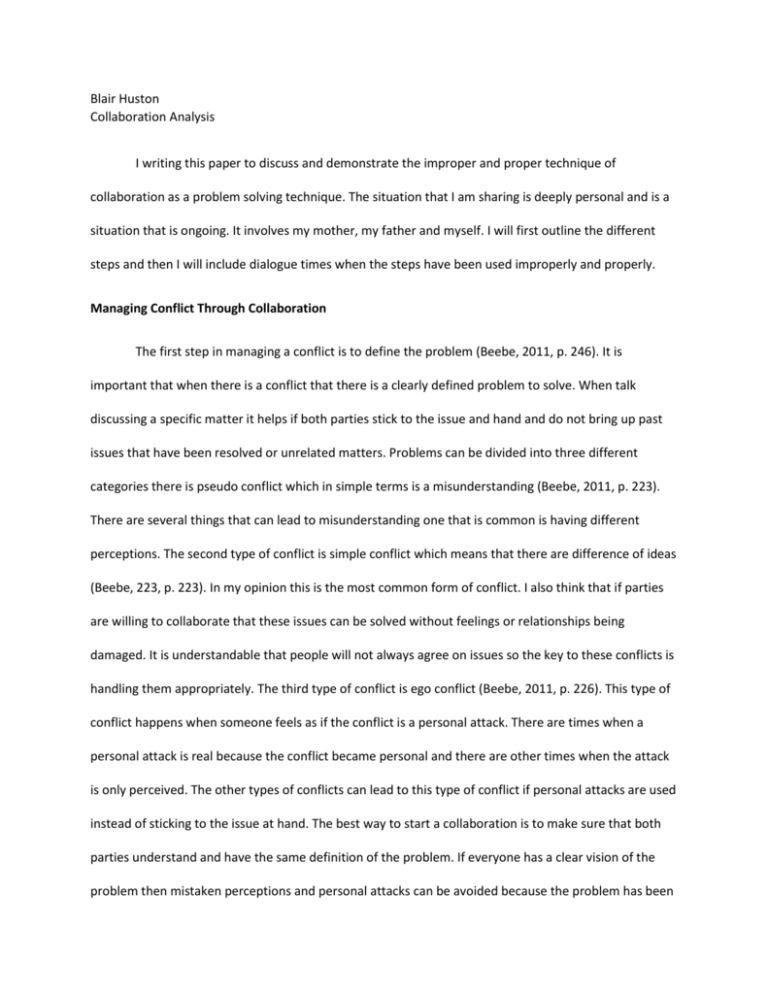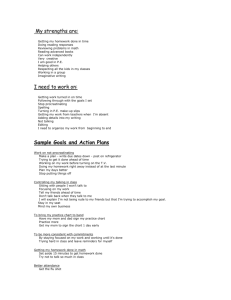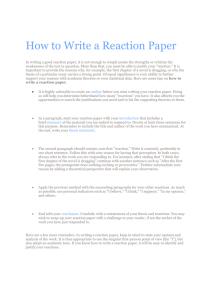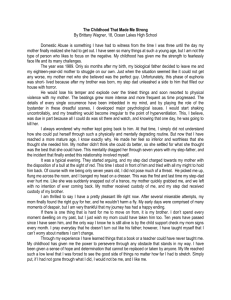File - Blair Huston
advertisement

Blair Huston Collaboration Analysis I writing this paper to discuss and demonstrate the improper and proper technique of collaboration as a problem solving technique. The situation that I am sharing is deeply personal and is a situation that is ongoing. It involves my mother, my father and myself. I will first outline the different steps and then I will include dialogue times when the steps have been used improperly and properly. Managing Conflict Through Collaboration The first step in managing a conflict is to define the problem (Beebe, 2011, p. 246). It is important that when there is a conflict that there is a clearly defined problem to solve. When talk discussing a specific matter it helps if both parties stick to the issue and hand and do not bring up past issues that have been resolved or unrelated matters. Problems can be divided into three different categories there is pseudo conflict which in simple terms is a misunderstanding (Beebe, 2011, p. 223). There are several things that can lead to misunderstanding one that is common is having different perceptions. The second type of conflict is simple conflict which means that there are difference of ideas (Beebe, 223, p. 223). In my opinion this is the most common form of conflict. I also think that if parties are willing to collaborate that these issues can be solved without feelings or relationships being damaged. It is understandable that people will not always agree on issues so the key to these conflicts is handling them appropriately. The third type of conflict is ego conflict (Beebe, 2011, p. 226). This type of conflict happens when someone feels as if the conflict is a personal attack. There are times when a personal attack is real because the conflict became personal and there are other times when the attack is only perceived. The other types of conflicts can lead to this type of conflict if personal attacks are used instead of sticking to the issue at hand. The best way to start a collaboration is to make sure that both parties understand and have the same definition of the problem. If everyone has a clear vision of the problem then mistaken perceptions and personal attacks can be avoided because the problem has been clearly defined. Using active listening skills to make sure that everyone is one the same page is key to defining the problem. The second step is to analyze the problem (Beebe, 2011, p. 246). When you are analyzing the issue you should make sure to stick to the issue at hand so that discussion does not damage the relationship. Since we are discussing collaboration we understand at least a decent portion of the other person’s background and personal experience when can help us to understand the problem at hand. If I grew up in a household that was very family oriented and my partner did not then we are not going to have the same ideas about how families operate. Understanding background information helps to analyze where the problem stemmed from and how to move forward. When a problem is analyzed then we are able to see where the issue originated which may or may not be how the other person viewed the issue that’s why analyzing the issue together can be very important. The third step is to determine goals (Beebe, 2011, p. 246). Just like with personal goals it is best to make goals that are realistic and measurable. If you make goals based on some sort of perception then it will be unclear when the goal is reached. If I were to come up with a goal with my partner that we need to save enough money that we have a buffer in case we fall on hard times that could mean something completely different to me than it is to my partner. If we came up with a goal that we need to save four thousand dollars than that goal is easily measured and we both know when that goal is achieved. Setting clear goals will also assist both parties from getting into further conflict because they have a clear understanding of what the other party wants. If there are not clear goals then it leaves the door open not only for future conflict but also for resents to form which can damage relationships. The fourth step is to generate multiple solutions (Beebe, 2011, p. 246). It’s nice to be able to brainstorm with someone that you trust. This is very important step in the collaboration process. It will help you to come up with solutions for the conflict at hand but you will also be able to see where the other person’s strong points and weaknesses are. For me I know that sometimes I can be a bit emotional when a conflict initially rises and I know that my Dad is quite practical so when I think that I am making decisions based on emotion I run it past my Dad to get another angle. Learning these types of things about people that you are close will build trust and understanding. When you are brainstorming solutions it is helpful for both people to be able to contribute ideas with threat of judgment or rejection. If both parties can reserve their opinions about the other person’s ideas until all solutions are out on the table then both parties will feel understood and cared for. The last step is to select the best solution (Beebe, 2011, P. 247). The solution be something that both parties feel good about since it will most likely take teamwork to implement the solution. In most cases there is a chance for compromise in other’s there is not. One situation that comes to mind is in the case of divorce sometimes there is no way to save the marriage but both parties can save face if they can agree to still co-parent and work together for the sake of the children. Once the best solution has been chosen there will usually need to be some sort of implementation and follow up. Both parties should be aware of the progress that they are making towards their goal. If both parties agreed to save ten percent of their paychecks then it would be likely at payday that they sit down together and transfer money into their savings account. If it is a goal to plan a vacation for the summer than both parties would be actively planning and following up with their partner to make sure that they were ready for the trip. Once a conflict has arisen and been overcome through collaboration it not only benefits both parties but their relationship as a whole. The parties involved learn that they can effectively work together and these steps become easier with each challenge that is overcome together. The conflict that I have been able to resolve is something that is very personal to me but I feel like it fits the collaborative model of communication very well. I am currently going through a divorce. The father of my young children has shown through his actions that he is not going to be an involved parent to his children. When the situation began my parents and I had several conversations as to what would be in the best interest of the children since he was not being cooperative. The situation has had been through changes and throughout the last eighteen months the situation has had to be revisited and the best solution has undergone changes. Since this has been an emotional situation there have been hurt feelings along the way but they have always been resolved because the people that are involved all have a common goal which is imperative. When the situation first happened I thought that it would be best to let my soon to be exhusband relinquish his parental rights. I knew that financially it would be tight while the children were young but that the pros of him not being able to come in and out of their lives far outweighed the negative. My mother as adamantly against this at first and it took several conversations to brainstorm and come to the best solution. Here were some of the dialogue that took place that did not help us reach a solution. Me: I really think that letting him sign over his rights would be best for the kids in the long run. Mom: I think you would be foolish to let him get away with leaving his responsibility. Dad: Let’s think about what the implications of this decision would be. Looking back it was clear that my mom had two goals in mind, one was to do what was best for the kids and the other was to hold my ex accountable for his actions. We spoke for a long time about what the goal would be and sometimes though two goals were not congruent. My Dad and I were able to get on the same page much quicker than my Mom was. It took a few months and lots of taking to get there. One of the things that really helped was understanding that she felt protective of me since she is my Mom and that was not something that was even a concern to me since I am an adult. A conversation that took place between her and I that did not end well played out like this: Me: Mom I really need you to get on board with what Dad and I have decided. Mom: I am so tired of being left out of decisions that have an effect on my life it shouldn’t be up to you and your Dad to decide anything. You should just be lucky that we are even here to help you. Me: I don’t need the guilt trips this was not my decisions and the situation is out of my control. I am just trying to move on with my children the best way that I know how to do. Mom: Well if you are needing to move on the only real way to do that is to take child support from him and just hope that he doesn’t see the children. Me: I can’t believe that you think that is the only option here I wish you weren’t so shortsighted. The issue with this conversation happened even before anyone started talking because we really didn’t check in with each other to see if both parties were able to discuss the topic calmly. There was clearly a lot of emotion happening and it became personal instead of issue based very quickly. Since we have a lot of information about each other we both know how to effectively wound each other in a discussion if we choose to. This is something that my Mom and I constantly have to work through. Once there had been some time and space for everyone to look at things effectively and from all angles this is what the conversation looked like using the problem solving process. Define The Problem: Me: I want the children to have a stable happy childhood and to minimize the damage that their father not being involved or being minimally involved will have on them. Dad: I agree that’s the goal the only issue in my mind is that we need to make sure that we come together as a family and financially support them as well. Mom: I agree that we need to provide a family stable unit for them and to make sure that their needs are taken care of. Analyze The Problem: Me: It was more of a concern that he would come in and out of their lives when he lived close now that he lives a few states away I do not think that he will make an effort to come and see them. It has also been so long know that he would have to go through a lot of legal hoops to be able to get visitation and if he is willing to go through all of those at that point it would be wise to sit down and talk again about what role he could play in their lives. I think at this point it would be unwise to let him sign over his rights to them since he really should be responsible for them at least financially. Dad: I agree with everything that you have said my only concern would be if something were to happen to you what would happen to the kids. Mom: I feel more comfortable about the situation know that you have some legal safeguards to help you protect the children. Determine The Goals: Me: I think that goal for the present time is to collect child support from him and then reevaluate when and if I ever get remarried. Dad: At that point the decision will not involve me or your mom Mom: I think that is a good goal it’s nothing we can set in stone indefinitely since it involves a player that has left the situation but does have the option to return. Generate Multiple Solutions: Dad: I feel good about what we have decided but I would also like to see you get a living will to leave us the custody of the children in case anything were to happen to you. Me: I think that’s a great point I can talk to my lawyer about what my options are when it comes to that. Mom: I would also like to make sure that we leave the door to his extended family open so that the children have as much family as possible also so they know where they come from. Me: I know that will be hard for me at times because I have never really gotten along with his mother. Dad: Well maybe they can visit the kids when they are with us and you are out taking a little bit of time for yourself. That way they can still know who they are but it doesn’t leave you dealing with them all by yourself. Me: I think that could be a good compromise and I can always take them to family parties and such so there isn’t any tension. Select The Best Solution: Me: I think that we should implement all of the things that we have been talking about. I think that as long as the situation doesn’t change then this will be the best course of action. Dad: I think so too I know that as long as we stick together as a family then we will be able to handle whatever comes up. Mom: I agree we really are the best. Being able to really sit down with each other and discuss this topic has been a long time coming. We went through a lot of trial and error and sometimes we had set backs. Understand where each person stood on the matter was really the key to getting on the same page. My Dad’s main concerns about what ever happened was usually something to do with money. My father is very practical and he is extremely good with finances. He was always the one to discuss money or how we were going to make things happen. When it first happened I immediately went back to school to finish my degree because we discussed him helping me out with the kids until they were a little bigger and I could work full time. In the meantime I agreed that I would finish my degree so that I could be the best bread winner that I possibly could be. To effectively be able to problem solve my Mom really had to get over some intense reactions that she had to the situation. She has always been very protective of her children so she had a lot of feelings of revenge. Once she was able to work through some of that conversations were less emotional and more issue based. The hurdle that I had to overcome was being too optimistic. I wore rose colored classes as a defense to all the changes that were taking place. I wanted things to work out in ways that might have been unrealistic. Looking back I feel lucky to see that we each brought something very useful to the table. We all looked and the situation differently and were able to challenge each other and push each other to better solutions. My mom and I were talking about it today as I was writing this paper and we both had the same thought that rising to the occasion and being able to collaborate on this has brought us closer together as a family and has made us better people. I want to remember that next time I have the chance to collaborate on something that might be life changing. I know that when everything first started the best solution that we agreed on and felt comfortable with was not even something that I would have supported but now everyone is fully on board. Practicing these problem solving skills on smaller issues will really assist my family on working together when a big decision that requires collaborative effort comes up. Works Cited: Beebe, S., Beebe S., & Redmond, M. (2011) Interpersonal Communication: Relating To Others (6th Ed.) Boston: Pearson Publishers







